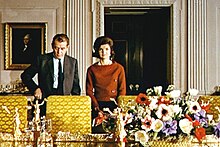
Franklin James Schaffner was an American film, television, and stage director. He won the Academy Award for Best Director for Patton (1970), and is known for the films Planet of the Apes (1968), Nicholas and Alexandra (1971), Papillon (1973), and The Boys from Brazil (1978). He served as president of the Directors Guild of America between 1987 and 1989.
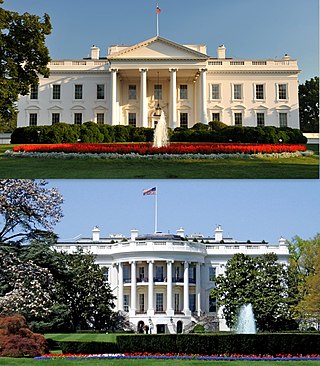
The White House is the official residence and workplace of the president of the United States. It is located at 1600 Pennsylvania Avenue NW in Washington, D.C., and has been the residence of every U.S. president since John Adams in 1800 when the national capital was moved from Philadelphia to Washington, D.C. The term "White House" is often used as metonymy for the president and his advisers.

Jacqueline "Jackie" Lee Kennedy Onassis was an American socialite, writer, photographer, and book editor who served as the first lady of the United States from 1961 to 1963, as the wife of President John F. Kennedy. A popular first lady, she endeared the American public with her devotion to her family, dedication to the historic preservation of the White House, the campaigns she led to preserve and restore historic landmarks and architecture along with her interest in American history, culture and arts. During her lifetime, she was regarded as an international icon for her unique fashion choices, and her work as a cultural ambassador of the United States made her very popular globally.
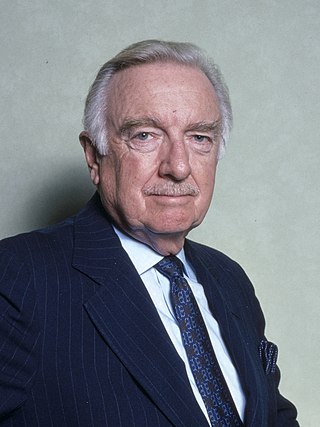
Walter Leland Cronkite Jr. was an American broadcast journalist who served as anchorman for the CBS Evening News for 19 years, from 1962 to 1981. During the 1960s and 1970s, he was often cited as "the most trusted man in America" after being so named in an opinion poll. Cronkite received numerous honors including two Peabody Awards, a George Polk Award, an Emmy Award and in 1981 was awarded the Presidential Medal of Freedom by President Jimmy Carter.
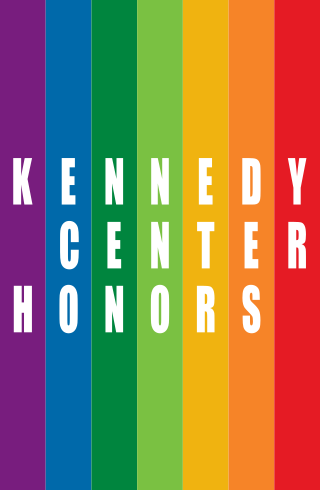
The Kennedy Center Honors are annual honors given to those in the performing arts for their lifetime of contributions to American culture. They have been presented annually since 1978, culminating each December in a gala celebrating five honorees in the Kennedy Center Opera House in Washington, D.C. While the awards are primarily given to individuals, they have occasionally been given to couples or musical groups, as well as to one Broadway musical and one television show.
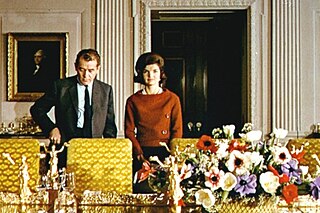
Charles Collingwood was an American journalist and war correspondent. He was an early member of Edward R. Murrow's group of foreign correspondents that was known as the "Murrow Boys". During World War II, he covered Europe and North Africa for CBS News. Collingwood was also among the early ranks of television journalists who included Walter Cronkite, Eric Sevareid, and Murrow himself.
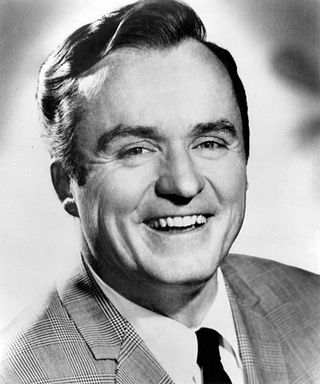
The Mike Douglas Show was an American daytime television talk show that was hosted by Mike Douglas. It began as a local program in Cleveland in 1961 before being carried on other stations owned by Westinghouse Broadcasting. The show went into national syndication and was moved to Philadelphia in 1965. The program ran until 1981. It was distributed by Westinghouse Broadcasting, and for much of its run, originated from studios at two of the company's TV stations in Cleveland and Philadelphia.

The Resolute desk, also known as the Hayes desk, is a nineteenth-century partners desk used by several presidents of the United States in the White House as the Oval Office desk, including the five most recent presidents. The desk was a gift from Queen Victoria to President Rutherford B. Hayes in 1880 and was built from the oak timbers of the British Arctic exploration ship HMS Resolute. The 1,300-pound (590-kilogram) desk was created by William Evenden, a skilled joiner at Chatham Dockyard in Kent, probably from a design by Morant, Boyd, & Blanford.

The Blue Room is one of three state parlors on the first floor in the White House, the residence of the president of the United States. It is distinctive for its oval shape. The room is used for receptions and receiving lines and is occasionally set for small dinners. President Grover Cleveland married Frances Folsom in the room on June 2, 1886, the only wedding of a President and First Lady in the White House. The room is traditionally decorated in shades of blue. With the Yellow Oval Room above it and the Diplomatic Reception Room below it, the Blue Room is one of three oval rooms in James Hoban's original design for the White House.
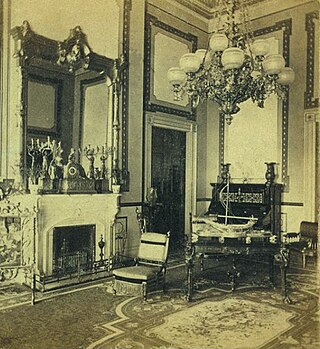
The Red Room is one of three state parlors on the State Floor in the White House, the Washington D.C. home of the president of the United States. The room has served as a parlor and music room, and recent presidents have held small dinner parties in it. It has been traditionally decorated in shades of red. The room is approximately 28 by 22.5 feet. It has six doors, which open into the Cross Hall, Blue Room, South Portico, and State Dining Room.

The Cross Hall is a broad hallway on the first floor in the White House, the official residence of the president of the United States. It runs east to west connecting the State Dining Room with the East Room. The room is used for receiving lines following a State Arrival Ceremony on the South Lawn, or a procession of the President and a visiting head of state and their spouses.
Alfredo Antonini was a leading Italian-American symphony conductor and composer who was active on the international concert stage as well as on the CBS radio and television networks from the 1930s through the early 1970s. In 1972 he received an Emmy Award for Outstanding Achievement in Religious Programming on television for his conducting of the premiere of Ezra Laderman's opera And David Wept for CBS television during 1971. In addition, he was awarded the Order of Merit of the Italian Republic in 1980

The Treaty Room is located on the second floor of the White House, the official residence of the president of the United States. The room is a part of the first family's private apartments and is used as a study by the president.
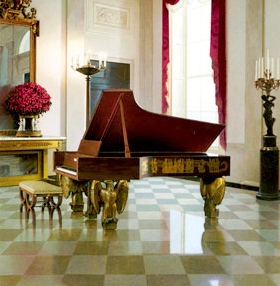
The Entrance Hall is the primary and formal entrance to the White House, the official residence of the president of the United States. The room is rectilinear in shape and measures approximately 31 by 44 feet. Located on the State Floor, the room is entered from outdoors through the North Portico, which faces the North Lawn and Pennsylvania Avenue. The south side of the room opens to the Cross Hall through a screen of paired Roman Doric columns. The east wall opens to the Grand Staircase.
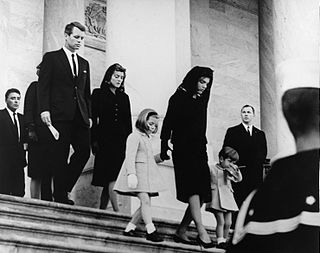
The state funeral of U.S. President John F. Kennedy took place in Washington, D.C., during the three days that followed his assassination on Friday, November 22, 1963, in Dallas, Texas.
A Look at Monaco was a CBS television special and documentary broadcast in the United States on 17 February 1963. The film featured a tour of the Principality of Monaco conducted by the former American actress Grace Kelly, who had become the Princess of Monaco following her 1956 marriage to Prince Rainier III. The couple's children, Princess Caroline and Prince Albert, were also featured in the film.
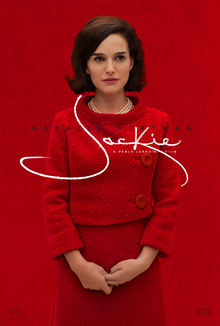
Jackie is a 2016 biographical drama film directed by Pablo Larraín and written by Noah Oppenheim. The film stars Natalie Portman as Jacqueline Kennedy. Peter Sarsgaard, Greta Gerwig, Billy Crudup, and John Hurt also star; it was Hurt's final film released in his lifetime before his death in January 2017. The film follows Kennedy in the days when she was First Lady in the White House and her life immediately following the assassination of her husband, United States President John F. Kennedy, in 1963. It is partly based on Theodore H. White's Life magazine interview with the widow at Hyannis Port, Massachusetts, in November 1963.
Jacqueline Kennedy: The White House Years was a 2001 exhibition that was presented by the Costume Institute at the Metropolitan Museum of Art. The event was timed to mark the 40th anniversary of her "emergence as America’s first lady." Organized by The Metropolitan Museum of Art and the John F. Kennedy Library and Museum, the exhibition was devoted to exploring the former First Lady's iconic style and impact on the fashion world.
"The Raider" was an American television play broadcast on February 19, 1959 as part of the CBS television series, Playhouse 90. The cast included Frank Lovejoy, Donald Crisp, and Rod Taylor. Franklin Schaffner was the director and Loring Mandel the writer.

Jacqueline Kennedy took a goodwill tour of India and Pakistan in 1962. While the media gave widespread coverage on her fashion style, she functioned as an informal diplomat and developed her interest in arts and architecture, returning to India in later years to co-produce a book on Indian artwork.
